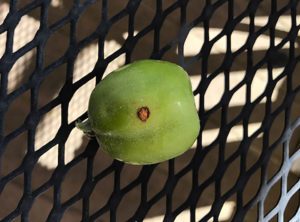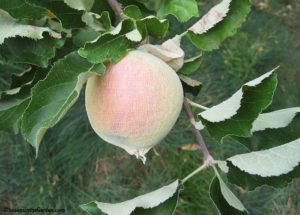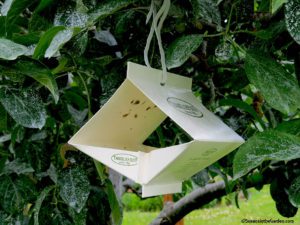Apple Codling Moths
Size: 1/2- to 3/4-inch long
Color: Drab gray/brown
Life cycle: The pupae overwinter in the soil or under loose bark on trees. They emerge as adult moths in early spring and mate; the female lay eggs on the trees, fruit or fruit spurs. Larvae hatch and burrow into the fruit to feed on the seeds. When ready to pupate, the larvae either drop out of the fruit and into the soil or in leaves or other debris under the tree (a very good reason to keep your orchard tidy!) OR crawl out of the fruit and down the tree, hiding under loose bark. When they emerge as adult moths, they start the cycle all over again. There can be about 2 to 4 generations during a growing season.
 Signs of their activity: Entry holes into the apple, holes with frass (see photo), worm in core of apple.
Signs of their activity: Entry holes into the apple, holes with frass (see photo), worm in core of apple.
Typically seen on: Apple, pear, crabapple and walnut trees
Controls: Monitor for codling moth presence with traps. Use a combination of the following sprays on foliage and fruit: A) mixture of Kaolin clay and water; B) Spinosad; or C) Bt. ALWAYS follow the label directions on sprays and other commercial products! Cover apples with nylon apple maggot barriers (see bottom photo). Note that larger orchards use mating disruption with pheromones.
 Cultural controls: Always dispose of (do not compost) thinned apples, damaged apples that have dropped onto the ground and damaged apples on the tree. Rake up leaves under the trees. Remove any nearby host trees that are not being taken care of.
Cultural controls: Always dispose of (do not compost) thinned apples, damaged apples that have dropped onto the ground and damaged apples on the tree. Rake up leaves under the trees. Remove any nearby host trees that are not being taken care of.
Natural predators: Some spiders or beetles might feed on larvae or pupae. The parasitic wasp Trichogramma platneri might prey on the adult codling moth but no research studies are available at this time.
Additional information: University of California Pest Management Guidelines. Codling Moth Management. Apple Codling Moth from PNW Pest Management Handbooks. Also be sure to read Susan Mulvihill’s blog post regarding the timing of the organic controls she uses: Growing Apples Organically 2017.
Back to Organic Pest Control

